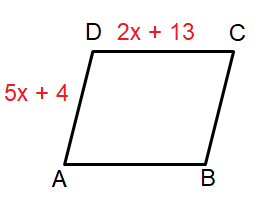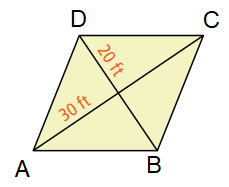APPLYING PROPERTIES TO FIND SIDE LENGTH OF RHOMBUS
Subscribe to our ▶️ YouTube channel 🔴 for the latest videos, updates, and tips.
In rhombus,
- All sides are equal.
- Diagonals will bisect each other at right angles,
- The diagonals are equal.
Problem 1 :
Find the side length of rhombus given.

Solution :
Since the given shape is rhombus, all sides will have equal measure.
AD = DC
5x + 4 = 2x + 13
5x - 2x = 13 - 4
3x = 9
x = 9/3
x = 3
Applying the value of x, we get
AD = 5(3) + 4
AD = 15 + 4
AD = 19
Problem 2 :
Find the side length of the rhombus ABCD.

Solution :
Let E be the point of intersection of two diagonals. Considering the triangle DEC,
DE = 20 ft, EC = 30 ft
DC2 = DE2 + EC2
DC2 = 202 + 302
DC2 = 400 + 900
DC2 = 1300
DC = 10√13
Problem 3 :
The area of a rhombus is 150 cm2. The length of one of its diagonal is 10 cm. The length of their other diagonal is .
(a) 25 cm (b) 30 cm (c) 35 cm (d) 40 cm
Solution :
Area of rhombus = (1/2) x d1 x d2
(1/2) x 10 x d2 = 150
d2 = 150 / 5
d2 = 30 cm
Problem 4 :
One of the diagonals of a rhombus is double the other diagonal. Its area is 25 sq.cm. The sum of the diagonal is
(a) 10 cm (b) 12 cm (c) 15 cm (d) 16 cm
Solution :
d1 = 2d2
(1/2) x d1 x d2 = 25
(1/2) x 2d2 x d2 = 25
d22 = 25
d2 = 5
then d1 = 2(5) ==> 10 cm
Sum of the diagonals = 10 + 5 ==> 15 cm
Problem 5 :
The perimeter of a rhombus is 56 m and height is 5 m. Its area is.
(a) 64 sq.cm (b) 70 sq.cm (c) 78 sq.cm (d) 84 sq.cm
Solution :
Perimeter of rhombus (4a) = 56
a = 56/4
a = 14 cm
height = 5 cm
Area of rhombus = base x height
= 14 x 5
= 70 sq.cm
Problem 6 :
If the diagonals of a rhombus are 24 cm and 10 cm, find the area and perimeter of rhombus.
Solution :
Area of rhombus = (1/2) x d1 x d2
d1 = 24 cm and d2 = 10 cm
= (1/2) x 24 x 10
= 120 square cm
To find perimeter of rhombus, we should find the side length of rhombus.
side2 = 122 + 52
side2 = 144 + 25
side2 = 169
= √169
= 13
Perimeter of rhombus = 4(13)
= 52 cm
Problem 7 :
Each side of a rhombus is 26 cm and one of its diagonal is 48 cm long. The area of the rhombus is.
(a) 240 cm2 (b) 300 cm2 (c) 360 cm2 (d) 480 cm2
Solution :
The diagonals will bisect each other at right angle.
Half length of given diagonal = 24
half length of another diagonal = x
262 = 242 + x2
676 = 576 + x2
x2 = 676 - 576
x2 = 100
x = 10
Length of another diagonal = 20
Area of rhombus = (1/2) x 48 x 20
= 480 square cm
Problem 8 :
The length one diagonal of a rhombus is 80% of the other diagonal. The area of the rhombus is how many times the square of length of the other diagonal ?
(a) 4/5 (b) 2/5 (c) 3/4 (d) 1/4
Solution :
Let d1 and d2 be length of diagonals.
d1 = 80% of d2 ==> 0.80d2
Area of rhombus = (1/2) x 0.80d2 x d2
= (1/2) x 0.80(d2)2
= 0.40(d2)2
= (40/100)(d2)2
= 2/5(d2)2
So, the answer is 2/5.
Subscribe to our ▶️ YouTube channel 🔴 for the latest videos, updates, and tips.
Recent Articles
-
Finding Range of Values Inequality Problems
May 21, 24 08:51 PM
Finding Range of Values Inequality Problems -
Solving Two Step Inequality Word Problems
May 21, 24 08:51 AM
Solving Two Step Inequality Word Problems -
Exponential Function Context and Data Modeling
May 20, 24 10:45 PM
Exponential Function Context and Data Modeling